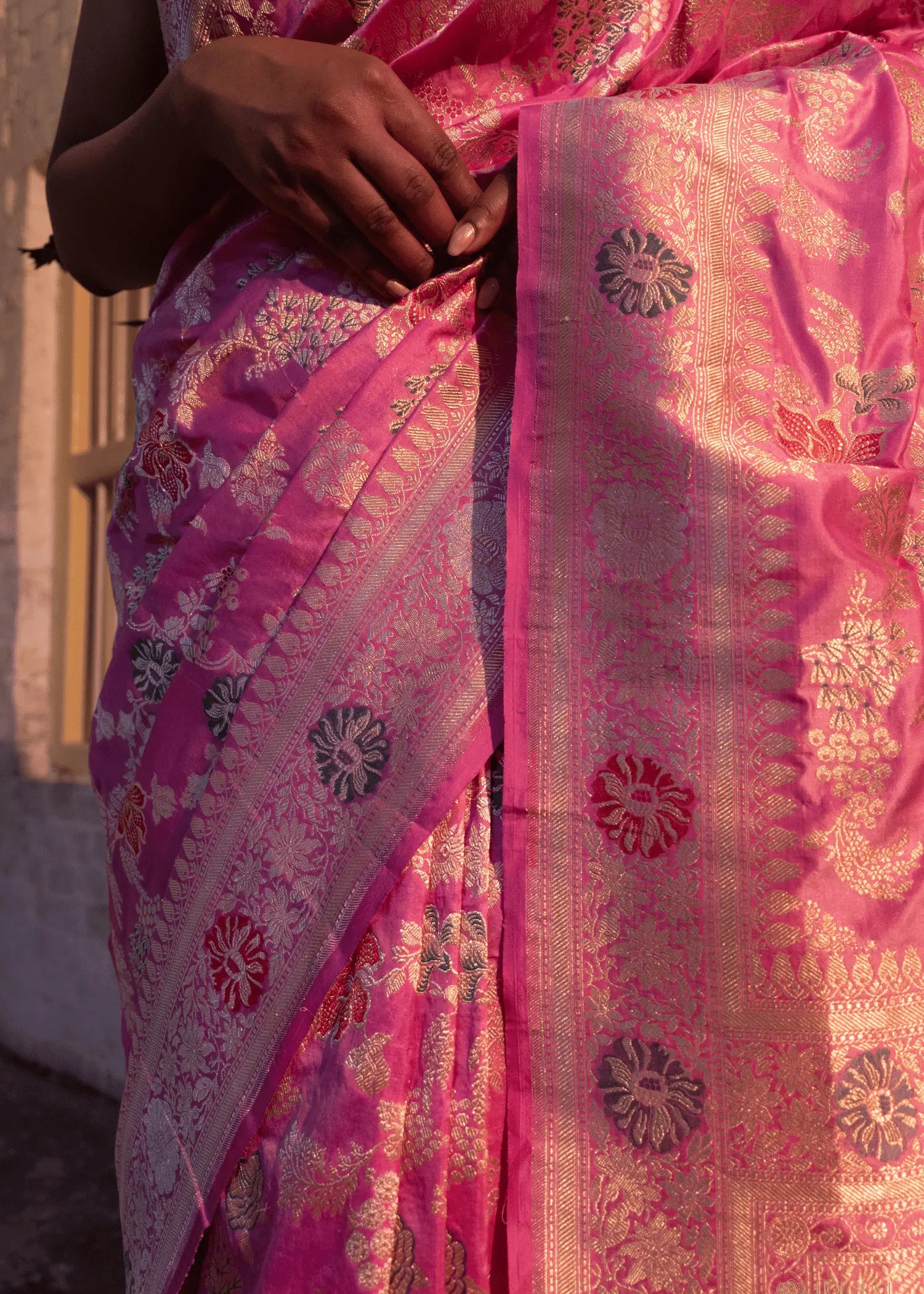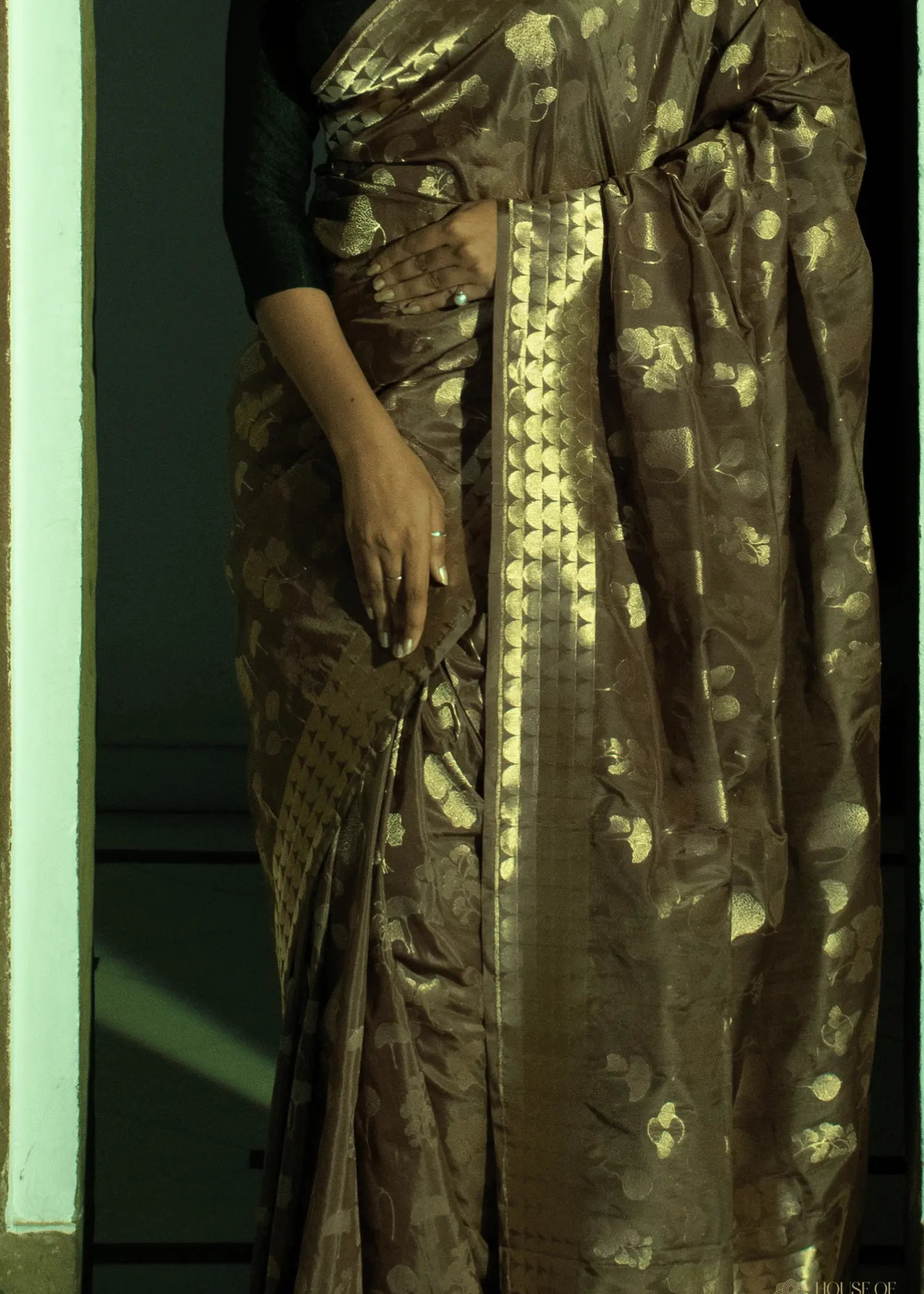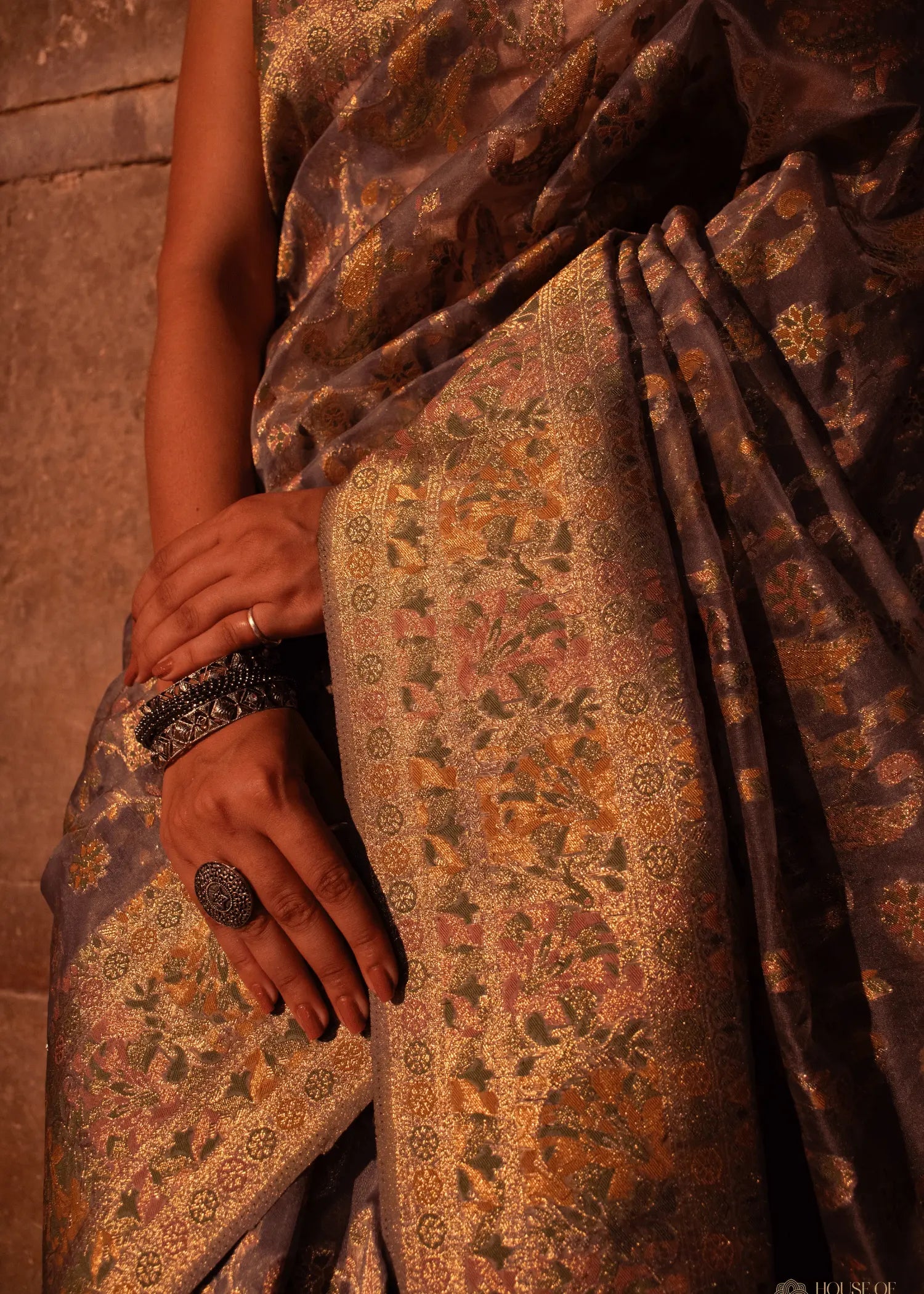Fabrics at House of Banaras
Banarasi fabrics are celebrated for their sumptuous textures, intricate designs, and luxurious allure. Each type of fabric embodies a rich heritage, showcasing the exquisite craftsmanship that Banaras is known for. Every piece of Banarasi fabric tells a unique story, weaving together the traditions and artistry of this historic city to create timeless masterpieces.
Banarasi Silk, one of the most luxurious and celebrated fabrics in India, traces its origins back to the rich cultural heritage of Varanasi, also known as Banaras. The history of Banarasi silk weaving dates back to the Mughal era, around the 16th century. The Mughal emperors, known for their appreciation of arts and crafts, patronized weavers from Gujarat who had migrated to Banaras. This migration was partly due to the devastating famine in Gujarat during that period. The blend of Persian and Indian artistic traditions during the Mughal rule gave birth to the intricate designs and patterns that define Banarasi silk today.
The fabric became synonymous with royalty and nobility, with its detailed brocade work, often in gold and silver threads, making it a prized possession. Over the centuries, Banarasi silk has maintained its esteemed status, being a preferred choice for bridal trousseau and special occasions. The traditional motifs, inspired by Mughal art, include intricate floral and foliate patterns, kalga and bel, and a string of upright leaves called jhallar at the outer edge of the border.
Nature of Fabric
Banarasi Silk is a finely woven, lustrous fabric known for its softness and rich texture. The silk threads used are of high quality, contributing to the fabric's smooth and luxurious feel.
Characteristics
Rich and Opulent: The fabric is known for its glossy finish and luxurious appearance.
Durable: Despite its delicate appearance, Banarasi silk is durable and can be passed down through generations.
Intricate Designs: The fabric often features complex designs woven with gold or silver threads.
Types of Work:
Brocade (Zari) Work: Involves weaving gold or silver threads into the fabric to create intricate patterns.
Meenakari: Enamel work that incorporates different colors into the brocade patterns.
Butidar: Dense, small motifs woven with zari threads.
Banarasi Silk is primarily used for making sarees, lehengas, dupattas, and sherwanis, suitable for weddings, festivals, and other grand occasions.
Georgette, originally a French fabric, found its place in the traditional weaving practices of Banaras to cater to the evolving fashion sensibilities. While traditional Banarasi fabrics were known for their heaviness and grandeur, the demand for lighter, more versatile fabrics led to the adoption of Georgette weaving. This transition allowed the weavers of Banaras to blend contemporary styles with traditional craftsmanship, making the fabric popular among younger generations and in global markets.
Banarasi Georgette has maintained its connection to the rich heritage of Varanasi by incorporating traditional designs and motifs into its lightweight structure. The introduction of Georgette in Banaras provided a new dimension to the weaving industry, enabling the creation of elegant and modern garments without compromising on the cultural significance and intricate detailing typical of Banarasi textiles.
Nature of Fabric
A lightweight, semi-sheer fabric with a crinkled texture. Georgette is known for its drape and flow, making it an excellent choice for creating elegant and comfortable garments.
Characteristics
- Soft and Flowy: The fabric drapes beautifully and moves gracefully.
- Comfortable: Ideal for wearing in warmer climates due to its light and airy nature.
- Subtle Elegance: Provides a modern yet traditional look.
Types of Work
- Zari Work: Use of metallic threads to create designs on the georgette fabric.
- Resham Work: Intricate silk thread embroidery that adds texture and detail.
- Banarasi Georgette is commonly used for sarees, salwar suits, gowns, and anarkalis, suitable for both casual and festive occasions.
Organza, a fabric with European origins, was embraced by the weavers of Banaras for its sheer, lightweight quality, which offered a contrast to the heavier traditional silks. Banarasi Organza, also known as Kora, became popular due to its ability to showcase intricate embroidery and zari work while maintaining an ethereal appearance. The fabric's adoption into Banarasi weaving traditions reflects the region's adaptability and innovation in textile arts.
Banarasi Organza has been used to create garments that exude grace and sophistication, making it a favorite for weddings, festivals, and other special occasions. The fabric's delicate nature requires skilled craftsmanship to ensure that the intricate designs and patterns are executed flawlessly. The incorporation of fine silk threads and detailed embroidery work has kept Banarasi Organza relevant and cherished in the modern fashion landscape.
Nature of Fabric
Sheer, lightweight, and crisp fabric. Organza is known for its translucent quality and subtle sheen, adding a touch of elegance to any garment.
Characteristics
- Sheer and Crisp: Provides a structured yet delicate look.
- Ethereal: Adds a sense of grace and sophistication to the wearer.
- Delicate Designs: Perfect for showcasing intricate embroidery and patterns.
Types of Work
- Zari Work: Delicate metallic thread embroidery that adds shimmer and elegance.
- Resham Work: Fine silk thread embroidery that enhances the fabric's beauty.
Banarasi Organza is often used for sarees, dupattas, and light festive wear, ideal for occasions where a subtle yet sophisticated appearance is desired.
Banarasi Chiffon, a fabric known for its lightness and grace, holds a special place in the rich tapestry of Banarasi textiles. The history of chiffon weaving in Banaras is intertwined with the city's long-standing tradition of producing luxurious and intricate fabrics. Introduced to cater to the demand for lightweight, breathable textiles, Banarasi Chiffon quickly gained popularity for its sheer elegance and versatility. The weavers of Banaras, renowned for their craftsmanship, adopted and refined the technique of chiffon weaving, infusing it with traditional motifs and patterns. The Mughal influence, with its emphasis on delicate and detailed designs, played a significant role in shaping the aesthetics of Banarasi Chiffon.
Nature of Fabric:
Banarasi Chiffon is a lightweight, sheer fabric made from finely twisted silk yarns. The fabric is known for its soft, smooth texture and elegant drape. Its translucence and lightness make it a popular choice for creating garments that are both comfortable and stylish. The delicate nature of chiffon requires meticulous handling and weaving, showcasing the weavers' expertise and attention to detail.
Characteristics:
- Lightweight and Airy: Banarasi Chiffon is extremely light and breathable, making it ideal for warm weather and layering.
- Elegant Drape: The fabric drapes beautifully, creating a flowing and graceful silhouette.
- Sheer and Translucent: Its sheer quality adds a touch of ethereal charm to any garment.
- Soft and Smooth Texture: The fine silk yarns give the fabric a soft and smooth feel against the skin.
Types of Work:
- Zari Work: Banarasi Chiffon often features delicate metallic thread embroidery. Gold and silver zari threads are intricately woven into the fabric to create shimmering patterns and motifs. This adds a touch of opulence and elegance to the light and airy chiffon.
- Resham Work: Intricate silk thread embroidery, known as Resham work, is commonly used on Banarasi Chiffon. This type of embroidery adds color and texture to the fabric, enhancing its visual appeal.
- Brocade Work: While less common, brocade patterns can also be found on Banarasi Chiffon, providing a subtle yet luxurious design element.
Banarasi Chiffon is used for making lehengas, dupattas, anarkalis, and other traditional Indian attire. The fabric's sheer quality makes it ideal for layering, adding a touch of elegance to both casual and formal outfits.





